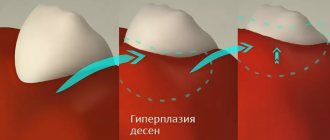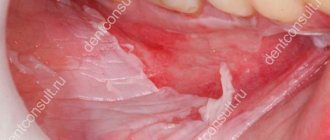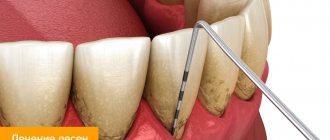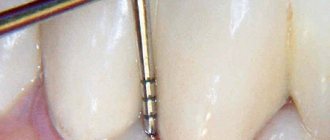Gum cancer is included in the group of malignant neoplasms of the oral cavity along with carcinomas of the tongue, floor, cheeks and palate. Malignant processes in different anatomical structures of the oral cavity proceed differently, the reasons for their development and treatment methods are similar.
- Causes of gum cancer
- Stages
- Symptoms of gum cancer
- Risk group
- Diagnosis of gum cancer
- Treatment for gum cancer
- Prevention
- Forecast
- Possible complications of gum cancer
Causes of gum cancer
Statistics know the annual incidence of oral cancer - almost 9,300 Russians, but the number of patients with gum or tongue cancer is unknown. Processes that are close in localization are not similar in prognosis, for example, in terms of aggressiveness, “two big differences”: gum tumor behind the wisdom tooth and under the rest of the dentition, the common thing is the causes leading to malignant transformation.
Until the 2000s, tumors of the oral cavity were considered to be the property of alcoholics and heavy smokers, and cancer processes in this area were called “marginal.” Alcohol and tobacco abuse of all types - smoking or chewing - are still top of the list of risk factors today.
In the 2000s, the population of young and never-smoking intelligent patients leading a sober and healthy lifestyle increased sharply. It was clear that this cohort did not have a generally accepted root cause of cancer, and it was found - infection with human papillomavirus type 16. Unlike cervical cancer, which is also associated with HPV infection, oral carcinomas are not considered markers of promiscuity; a single encounter with HPV-16 is sufficient to initiate the disease.
Modern risk factors also include background processes in the mucous membrane - leukoplakia and erythroplakia, which are initially benign, but with a great potential for proliferation, which can lead to carcinoma in the distant future.
The third cause of gum cancer is chronic trauma to the mucous membrane from dentures, as well as a sluggish inflammatory process maintained by damaged parts of the tooth that are not removed in a timely manner.
Failure to comply with oral hygiene is also included in the causal list, although modern foreign scientists are skeptical about this factor, suggesting that all people brush their teeth twice a day. As targeted surveys and examinations of dentists show, in our country not all social groups have the same level of hygiene, and for Russians this reason is still relevant.
Unlike tumors of all other areas of the oral cavity, which men suffer from several times more often, gum cancer is not gender specific - both sexes are affected equally. The increase in incidence begins after 40 years of life, with each subsequent decade of life marked by a doubling of the number of cases.
Tracheostomy
Sometimes surgery to treat advanced oral cancer can cause swelling in the throat. In this case, your surgeon may perform a tracheostomy to make sure you can breathe normally. A tracheostomy is an operation to create a surgical opening in the windpipe to make breathing easier and protect your airway. Before your surgery, your healthcare provider will discuss with you whether you will need a tracheostomy.
During a tracheostomy, your surgeon will make a hole in your neck and insert a tracheostomy tube into your trachea (windpipe). This will allow you to breathe easier. If you are having a tracheostomy, your nurse will give you the resource Care after a tracheostomy.
You will also have a tracheostomy if your surgery involves certain types of reconstruction or free flaps.
A nurse will care for your tracheostomy while you are in the hospital. Any mucus that forms will be removed using a suction tube. Keeping your airways clear will make breathing easier and reduce the risk of pneumonia.
The tracheostomy tube will be removed when the swelling in your airway has subsided and you can breathe normally. If you still have a tracheostomy after discharge, your nurse will teach you how to care for it.
to come back to the beginning
Stages
In most cases, gum cancer is not detected at an early stage, which is typical for all oral tumors. People are not used to looking into their own mouth until there is a good reason for this - pain that occurs when the periosteum is involved in the process.
The height of the gum of an adult is small, however, when staging cancer, the tumor is graded in “steps” of 2 centimeters: less than 2 cm, from 2 cm to 4 cm, and more than 4 cm, because malignant processes of the oral cavity are often non-nodular. , and flat infiltrates and ulcers.
The stages of gum cancer are distributed as follows:
- stage 0 or carcinoma in situ - cancer cells have not penetrated into the deep layers of the mucous membrane, as a rule, the disease is visually manifested by leukoplakia, an oncological diagnosis is established only by microscopy;
- Stage 1 - carcinoma is less than 2 cm and there are no signs of damage anywhere else;
- Stage 2 - the primary lesion is more than 2 cm, but less than 4 cm, grows no more than a centimeter deep, there are no metastases in the lymph nodes;
- Stage 3 involves variability in the size of the primary gum lesion, including more than 4 cm, without metastases or with cancer cells in one lymph node no more than 3 cm in diameter;
- Stage 4 is divided into subgroups:
- 4A - extensive tumor without involvement of lymph nodes, or smaller in size with a large lymph node, but not more than 6 cm;
- 4C - the local condition is not important because there are distant metastases.
4B - cancer growing into the jaw and surrounding tissues without metastases, or a smaller lesion with large or multiple tumor lymph nodes on either side of the neck;
Treatment results for cancer of the oral cavity and oropharynx
In patients with stage 0 cancer of the oral cavity and oropharynx, long-term survival is 95-100%, but if the disease recurs (returns), more serious surgery or radiation therapy may be required. These patients need to be aware that smoking can contribute to the development of another malignant tumor.
The use of surgery or radiation therapy in patients with stage I cancer allows long-term survival to be achieved in 80-85% of cases, and in stage II patients - in 60-80%.
In patients with stages III-IV cancer of the oral cavity and oropharynx, 2 or all 3 treatment methods are used. Long-term survival rates range from 20 to 50%.
Symptoms of gum cancer
Gum tumors are divided into:
- exophytic - growing outward and forming a node;
- endophytic - spreading deep into the gums, in the form of a flat infiltrate or ulcer;
- mixed - a combination of two growth options; as a rule, this is a far advanced or recurrent process.
I detect a knot on the surface of the gum at an early stage, because it gets in the way, the tongue “feels” for it, and it gets injured when brushing your teeth or while eating. Infiltrates grow faster and are found later, when complaints of pain or bleeding appear.
Cancer in the initial stage does not hurt, especially since the oral mucosa is accustomed to irritating, spicy foods and hot foods. Temporary discomfort while eating does not cause everyone anxiety with a desire to see what is happening there. Gum cancer can masquerade as toothache, forcing you to see a dentist. Most often, it is the dentist who discovers the malignant process.
In stages 3-4, when cancer grows into the jaw, destroying the bone, the pain becomes constant, sharply intensifying while eating, and due to basic malnutrition leading to significant loss of body weight.
A large cancerous ulcer is accompanied by inflammation of the surrounding tissues and decay, causing intense pain radiating to the ear and temple. Secondary infection of the cancerous infiltrate is inevitable; it is manifested by a “heavy” putrid odor. The patient cannot open his mouth due to a painful spasm of the masticatory muscles - trismus. The general condition worsens, the temperature rises, and weakness increases.
Citizens who abuse alcohol drown out the pain by increasing the dose of alcohol, and complain of the appearance of a painful and often inflamed metastatic lymph node under the jaw or on the neck. The presence of various microflora in the mouth complicates metastatic conglomerates in the lymph nodes with secondary infection; when the size is more than 3-4 cm, a zone of decay is formed in the center of the lymph node, often with the formation of a fistula. During this period, symptoms of intoxication with high fever appear.
A reflex increase in salivation with impaired swallowing is characteristic. Salivation is very profuse, so it is possible that saliva may be thrown into the respiratory tract at night with the development of aspiration pneumonia. All malignant tumors lead to increased thrombosis and ease of development of bacterial infection in a weakened body. An additional negative factor is malnutrition up to complete starvation with exhaustion and the development of the fatal anorexia-cachexia syndrome.
Distant metastases are not typical for gingival carcinoma, but recurrences are common after treatment. Cancerous destruction of oral tissues with frequent bleeding from vessels destroyed by the tumor against the background of chronic inflammation in metastatic lymph nodes leads to a serious condition and death.
Symptoms of gum cancer
- Firstly, any person should be alert to the breakdown of tissue in a certain area. Gum cancer is characterized by the formation of a growth of a certain size. It is imperative to pay attention to the appearance of numerous blood capillaries on this neoplasm.
- Secondly, the appearance of various seals of various configurations is abnormal for gum tissue.
- Thirdly, bleeding increases, accompanied by constant swelling of the gums.
If any suspicious symptom appears, the best option is to contact a specialist. Based on a personal examination, blood tests and other studies using modern equipment (radiography, tomography), the dentist will make a preliminary diagnosis. This disease is hidden behind the symptoms of gingivitis, leukoplaxia, leukoplaxia or ulceration.
Risk group
Knowledge of risk factors allows you to calculate a likely “candidate” for the development of oral cancer and timely modify behavior towards a healthy lifestyle, eliminating actions that are hazardous to health.
High-risk group for malignant processes in the gum area:
- People who smoke have celebrated their fortieth birthday, because the frequency of neoplasms increases with age and the “control point”, after which the incidence doubles with each decade of subsequent life, is precisely 40 years.
- Young people with a full range of risk factors. Before the age of 40, carcinomas of this localization are rare, but early introduction to tobacco simultaneously with chewing betel or nas, with persistence in the mucosal cells of the human papillomavirus type 16, significantly increases the chances of cancer.
An extremely high-risk group when the prospect of becoming a cancer patient over time is very high:
- Suffering from precancerous processes - leukoplakia and erythroplakia;
- Older people who smoke, use dentures, and the older they are, the more likely malignant transformation is;
- Adults with a hereditary predisposition, which is identified by the presence in the family of patients with oral carcinomas.
All patients at risk should visit the dentist at least twice a year and undergo treatment for precancerous processes.
Prevention of cancer of the oral cavity and oropharynx
Most oral and oropharyngeal cancers can be prevented by avoiding known risk factors.
Tobacco and smoking are the most important risk factors in the development of cancer of the oral cavity and oropharynx. The best solution for all people is not to start smoking, not to drink alcohol, or to sharply limit their consumption.
If you smoke and drink alcohol, even for a long time, then giving up these habits will significantly reduce the risk of cancer in these locations.
Avoiding sun exposure during the middle of the day, when exposure to ultraviolet radiation is greatest, will reduce your risk of developing lip and skin cancer.
A nutritious diet including plenty of vegetables and fruits several times a day and whole grain products will help reduce the incidence of cancer of the oral cavity and oropharynx.
Diagnosis of gum cancer
Oncopathology of the oral cavity is visual, that is, diagnosed during a routine examination without the use of any equipment.
During the initial examination, cells are scraped from the wound for cytological analysis, or, in the absence of an ulcer, the tumor is punctured with a thin needle. If possible, a part of the tumor is “bitten off” with a special instrument - this is a biopsy for histological analysis. The diagnosis of cancer is established solely by the result of a biopsy; cytology allows only to suspect the disease.
After morphological confirmation, an ultrasound of the oral cavity is performed, which explains the relationship of the neoplasm with the surrounding tissues, primarily with the bone and blood vessels, and the CT scan clarifies the condition of the entire anatomical region.
Next is the search for metastases: ultrasound of the neck, CT scan of the lungs or MRI.
Symptoms and signs
Poorly healing ulcers are a warning sign
Symptoms of any cancer can be variable. Often patients do not have any complaints until the tumor becomes large enough.
Symptoms depend on the location of the malignant growth and the individual body's response to the disease.
The most common symptoms include:
- The appearance of a lump, thickening, rough patch, or slight swelling in any area of the oral mucosa.
- Unexplained bleeding in the mouth.
- Numbness and loss of sensation in the face or neck.
- Constant appearance of sores in the mouth area.
- Painful sensations while eating food.
- Difficulties with chewing and swallowing. Speech dysfunction.
- Partial numbness of the tongue.
- Pain in the ear area.
- Gradual decrease in body weight.
The listed signs are not specific to oncology and may indicate a variety of diseases of the oral cavity. However, if such symptoms are detected, you should consult a doctor for a detailed diagnosis.
Treatment for gum cancer
It is optimal to perform the operation at the first stage, if technically possible. The radicality of the surgical intervention ensures a distance of at least 2 centimeters from the tumor border; it is clear that this is possible with a small stage 1 lesion.
At stages 2-3, the possibility of surgery is limited by the depth of penetration of cancer cells deep into the tissues of the jaw; with a large depth of infiltration, the process is considered questionably operable, but a lot is determined by the experience and talent of the oncologist surgeon. Techniques have been developed that make it possible to replace large surgical defects of the jaw with skin flaps, ribs, metal structures or artificial tissues. Plastic surgery may be postponed until antitumor treatment is completed.
If the tumor thickness is more than 4 millimeters, the surgical plan includes removal of the lymph nodes of the neck; if the cancer infiltration is localized in the middle of the oral cavity, the nodes are removed from both sides. Lymphadenectomy has a positive effect on life expectancy, but reduces its quality. It is possible to refuse lymphadenectomy if there are no metastases, which is proven or rejected by a morphological study of a biopsy obtained from a “sentinel” lymph node.
Surgery for cancer above stage 1 is complemented by prophylactic radiation, which should begin one and a half months after surgery.
Initially inoperable stage 3 tumor conglomerates are tried to be reduced by radiation in combination with chemotherapy with platinum derivatives, postponing surgery to the second stage.
Contraindications for surgery: stage 4, proliferation of metastases from the lymph node into the skin or tissue of the neck, severe diseases in the decompensation stage.
If surgery is not possible, 7 weeks of radiation therapy is performed on the primary lesion and lymph nodes of the neck, with the introduction of platinum chemotherapy every 3 weeks. If radiation is contraindicated, chemotherapy is used; this is also done in case of relapse after chemoradiotherapy.
Treatment of cancer of the oral cavity and oropharynx
When treating patients with cancer of the oral cavity and oropharynx, surgical, radiation and medicinal methods are used. In this case, depending on the stage of the tumor, one or more methods of therapy are used.
For the surgical treatment of tumors of the oral cavity and oropharynx, various operations can be used, taking into account the location of the tumor and the stage of the process, as well as the need to perform reconstructive (restorative) interventions in order to restore lost functions.
In patients with a mobile tumor in the oral cavity, the tumor is removed without excision of bone tissue. If the mobility of the tumor is limited and there are no changes in the bone (on x-rays), the tumor is removed along with part of the jaw. Clear damage to the jaw, visible on radiographs, requires wider excision of bone tissue.
If the lip is affected, in some cases a special surgical micrographic method can be used, in which the tumor is removed in layers and examined under a microscope. This allows you to completely remove the tumor and preserve as much normal lip tissue as possible.
Malignant tumors of the oral cavity and oropharynx often spread to the lymph nodes of the neck. In these cases, surgery to remove them and suspicious lymph nodes is indicated. The extent of the operation depends on the extent of the tumor and can be significant, including the removal of muscles, nerves and blood vessels.
Side effects and complications during surgical removal of lymph nodes are associated with nerve damage: numbness of the ear, difficulty raising the arm above the head, drooping of the lower lip. These phenomena may gradually subside, but may remain permanently if the nerve has been completely removed.
In some cases, for large tumors of the oropharynx that lead to difficulty breathing, a tracheotomy (cutting the trachea) is performed and a tube is inserted into the trachea to restore breathing. After the tumor is removed, the tube is removed and normal breathing is restored.
Radiation therapy may be the mainstay of treatment for patients with small tumors of the oral cavity and oropharynx. In patients with large tumors, radiation is used along with surgery to destroy remaining tumor cells. Radiation therapy is also used to relieve pain, stop bleeding, and eliminate difficulty swallowing.
For tumors of the oral cavity and oropharynx, external irradiation is most often used. Treatment is carried out 5 times a week for 5-7 weeks.
In some patients, brachytherapy (internal radiation) may be used. In this case, metal rods containing radioactive material are inserted into or near the tumor for a certain period of time. These rods are removed before discharge home.
In some cases, both external and internal irradiation are used.
Side effects of radiation therapy: redness of the skin, dry mouth, sore throat, hoarseness, partial loss of taste, weakness. Treatment complications may include: damage to the thyroid gland and blood vessels supplying the brain.
Chemotherapy refers to the use of anticancer drugs. It can be used before surgery or radiation therapy to shrink the tumor. In some cases, chemotherapy is used in combination with radiation or surgery.
The most commonly used chemotherapy for oral and oropharyngeal cancer is cisplatin and 5-fluorouracil. In addition, other drugs can be used: methotrexate, bleomycin, carboplatin. The drugs are used both individually and in combination to enhance the antitumor effect.
Side effects of chemotherapy may include nausea, vomiting, loss of appetite, baldness, mouth ulcers, fatigue, increased susceptibility to infection, and bleeding. Most side effects go away over time, but some, such as hearing loss with cisplatin, may be persistent.
Forecast
An individual prognosis for the course of the disease is based on the size of the neoplasm and the depth of its penetration deep into the jaw, involvement of vessels and nerves in the conglomerate.
The degree of damage to the lymph nodes affects life expectancy; metastases almost halve the likelihood of cure. Much determines the aggressiveness of cancer cells; low differentiation is not in favor of the patient.
Specific percentages by years of survival are unknown because the incidence is low and statistically gum cancer is not distinguished from the group of oral carcinomas.
About the oral cavity
Figure 1. Oral cavity
The oral cavity (or simply the mouth) is used for speech, chewing, swallowing, and breathing. The oral cavity consists of:
- lips;
- anterior two-thirds of the tongue;
- palate (hard and soft);
- floor of the mouth (under the tongue);
- lining of the inner surface of the cheeks (buccal mucosa);
- gums;
- a small area behind the wisdom teeth on the lower jaw (retromolar triangle).
to come back to the beginning
Possible complications of gum cancer
First of all, patients are concerned about the cosmetic consequences of treatment; in this regard, chemoradiation treatment is preferable, but is fraught with a higher frequency of relapses and is inferior to surgery in terms of survival.
The list of dangerous complications of carcinoma includes deterioration in nutrition with exhaustion and the development of fatal anorexia-cachexia syndrome. Long-term cancer-preventive therapy worsens nutritional status and worsens underweight. From the first days of treatment, the patient necessarily needs nutritional correction and nutritional support with special protein mixtures. In some periods, the patient may require tube and parenteral nutrition, since swallowing is seriously impaired and spasm of the facial muscles develops, up to the inability to open the mouth due to trismus.
Malnutrition and tooth loss after irradiation worsen the course of concomitant diseases and contribute to the development of infections against the background of a natural decrease in immunity. A change in the swallowing reflex due to too intense production of saliva, literally flowing in a stream, leads to the night-time reflux of saliva with food debris and bacterial flora into the respiratory tract and the occurrence of severe aspiration pneumonia.
Blockage of lymph outflow and proliferation of neck vessels by metastatic lymph nodes is complicated by constant headaches and loss of consciousness.
The disintegration of a cancerous ulcer is fraught with bleeding, which can only be stopped by ligation of the artery. Tumor masses growing into the bones cause intense pain, aggravated by secondary infection. The most severe suffering for the patient's family is caused by the disintegration of a cancerous ulcer with the addition of a secondary infection and a foul odor. It is absolutely impossible to clear a progressive tumor of necrosis on your own; this is a very difficult task even for specialists.
Treatment of such patients is a great oncological art, which is available to the specialists of our clinic. We are ready to help any patient, with or without complications, who has been treated for a long time and is just beginning to fight for life.
Book a consultation 24 hours a day
+7+7+78
Bibliography:
- Alieva S.B., Alymov Yu.V., Kropotov M.A. etc. /Cancer of the oral mucosa. Oncology. Clinical recommendations // Ed. Davydova M.I.; M.: Publishing group RONC, 2015.
- Gelfand I.M., Romanov I.S., Udintsov D.B. /Tactics for the treatment of localized forms of cancer of the oral mucosa// Tumors of the head and neck; 2016; 6.
- Romanov I.S., Yakovleva L.P. /Issues of treatment of oral cancer// Farmateka; 2013; 8.
- Kurokawa H., Yamashita Y., Takeda S. et al. /Risk factors for late cervical lymph node metastases in patients with stage I or II carcinoma of the tongue// Head Neck; 2002; 24.
- Little M., Schipper M., Feng FY et al. /Reducing xerostomia after chemo-IMRT for head-and-neck cancer: beyond sparing the parotid glands// Int J Radiat Oncol Biol Phys; 2012; 83.
- Midgley AW, Lowe D, Levy AR et al. /Exercise program design considerations for head and neck cancer survivors// Eur Arch Otorhinolaryngol; 2018; 275(1).
Risk factors for developing cancer of the oral cavity and oropharynx
Several factors are now known to increase the likelihood of developing cancer of the oral cavity and oropharynx.
Age. The likelihood of developing oral and oropharyngeal cancer increases with age, especially after age 35.
Floor. Oral cancer is more than 2 times more likely to occur in men than in women.
Tobacco. 90% of patients with malignant tumors of the oral cavity and oropharynx indicate their use of tobacco in the form of smoking or chewing. The risk of cancer increases with the amount of cigarettes smoked or chewed tobacco.
Among smokers, cancer of the oral cavity and oropharynx occurs 6 times more often than non-smokers.
35% of patients who continue to smoke after cancer treatment subsequently develop other malignancies of the oral cavity, oropharynx, or larynx, compared with 6% of people who stop smoking.
Pipe smokers have a significant risk of lip cancer.
Chewing tobacco most often causes cancer of the cheek, gums and lips and increases the risk of developing cancer in these areas by 50 times.
Working or living among smokers (passive smoking) is also a risk factor for cancer of the oral cavity and oropharynx.
Alcohol. Alcohol consumption significantly increases the risk of oral and oropharyngeal cancer among smokers.
75-80% of patients with oral cancer report drinking alcohol in significant quantities. In people who drink, cancer of this location is 6 times more common compared to people who don’t drink.
Ultraviolet radiation. 30% of patients with lip cancer had jobs that required prolonged exposure to the open air.
Irritation. It has been suggested that poorly fitting dentures that cause irritation to the oral mucosa may increase the risk of developing oral cancer.
Nutrition. A poor diet low in vegetables and fruits increases the risk of oral and oropharyngeal cancer.
Suppression of the immune system by taking special medications, for example to prevent organ transplant rejection, may increase the risk of cancer of the mouth and oropharynx.










